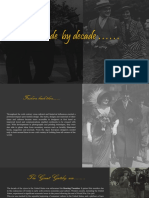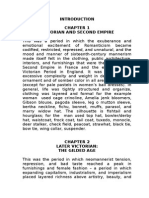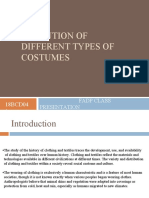History of Fashion
History of Fashion
Uploaded by
kohibat180Copyright:
Available Formats
History of Fashion
History of Fashion
Uploaded by
kohibat180Copyright
Available Formats
Share this document
Did you find this document useful?
Is this content inappropriate?
Copyright:
Available Formats
History of Fashion
History of Fashion
Uploaded by
kohibat180Copyright:
Available Formats
The history of fashion is a rich and dynamic narrative that reflects
cultural, social, and economic changes over centuries.
Ancient Civilizations: Fashion can be traced back to ancient
civilizations, including Egypt, Mesopotamia, Greece, and Rome. In these
societies, clothing often denoted status and function, with fabrics and
ornamentation indicating social hierarchies. For instance, in ancient
Egypt, wealthy individuals wore linen, while laborers used coarser
materials.
Middle Ages: The Middle Ages saw a shift toward more structured garments.
Clothing was typically layered, and the influence of the church meant
that modesty became a significant concern. Sumptuary laws regulated what
individuals could wear based on their social status.
Renaissance: The Renaissance (14th-17th centuries) marked a period of
significant change, characterized by elaborate designs, luxurious
fabrics, and vibrant colors. Fashion became more expressive, with the
emergence of fashion innovators and the introduction of tailoring
techniques that enhanced fit.
17th and 18th Centuries: The Baroque and Rococo periods were known for
opulence, with men and women wearing extravagant garments embellished
with lace, ribbons, and embroidery. The Industrial Revolution in the late
18th century transformed fashion production, leading to the rise of
ready-to-wear clothing and patterns.
19th Century: The 19th century introduced distinct styles, including
crinolines, bustles, and corsets for women, alongside tailored suits for
men. The establishment of fashion houses and designers began during this
time, with figures like Charles Frederick Worth gaining prominence.
20th Century: The 20th century was marked by rapid changes in fashion,
influenced by cultural movements, technological advancements, and global
events. The flapper styles of the 1920s, the elegance of Dior's "New
Look" in the 1940s, and the rise of youth culture in the 1960s and 70s
reflected shifting social norms. The late century saw the emergence of
streetwear and the globalization of fashion.
21st Century: Today, fashion continues to evolve, with a growing emphasis
on sustainability, inclusivity, and digital innovation. The industry
grapples with issues of fast fashion, ethical production, and the impact
of social media on trends and consumer behavior.
Overall, the history of fashion is a testament to human creativity and
the interplay between personal expression and societal influence over
time.
You might also like
- History of Fashion Through The DecadesDocument73 pagesHistory of Fashion Through The Decadesabhishek_sinha87% (15)
- Fashion PortFolioDocument62 pagesFashion PortFoliokerry100% (1)
- History of FashionDocument37 pagesHistory of FashionfedericaflowersNo ratings yet
- History of CostumeDocument1 pageHistory of Costumekohibat180No ratings yet
- Write Article Topic FashionDocument3 pagesWrite Article Topic Fashionrante putusNo ratings yet
- Article 4Document2 pagesArticle 4Hiba SiddiquiNo ratings yet
- Slidesgo The Evolution of Fashion A Study in Style 20240515002356mrcaDocument9 pagesSlidesgo The Evolution of Fashion A Study in Style 20240515002356mrcaMarie KolevaNo ratings yet
- TLEDocument3 pagesTLESean MarananNo ratings yet
- Evolution of Fashion TrendsDocument2 pagesEvolution of Fashion TrendsbuynzayahbatNo ratings yet
- Title 3Document2 pagesTitle 3shahad234123No ratings yet
- Modern Ages - Analysis of Men, Women, and Childrens Costumes of The Modern AgeDocument6 pagesModern Ages - Analysis of Men, Women, and Childrens Costumes of The Modern AgeSukran Jamil DurjoyNo ratings yet
- History of DressmakingDocument1 pageHistory of DressmakingLarelie AdilleNo ratings yet
- The Evolution of Fashion Through The DecadesDocument4 pagesThe Evolution of Fashion Through The DecadescoruzntNo ratings yet
- Advance Textile StudiesDocument7 pagesAdvance Textile StudiesalinaNo ratings yet
- Trend Timeline of Fashion Ix-XxDocument9 pagesTrend Timeline of Fashion Ix-XxMireyLopezNo ratings yet
- Fashion: "Fashion Is Like The Ashes Left Behind The Uniquely Shaped Flames of The Fire, The TraceDocument33 pagesFashion: "Fashion Is Like The Ashes Left Behind The Uniquely Shaped Flames of The Fire, The TraceEINSTEIN2DNo ratings yet
- The History of Clothing.: by Șerban Georgia RafaelaDocument22 pagesThe History of Clothing.: by Șerban Georgia RafaelaRafaela GeorgiaNo ratings yet
- EnglishDocument14 pagesEnglishShrey SinghNo ratings yet
- In An Influential FashionDocument390 pagesIn An Influential FashionReham Magdy100% (1)
- In General, The Term Fashion Refers To A Prevailing Mode of Expression, Whether It Be Custom, Style of Dress, Speech, or OtherDocument1 pageIn General, The Term Fashion Refers To A Prevailing Mode of Expression, Whether It Be Custom, Style of Dress, Speech, or OthernidhisanjeetNo ratings yet
- Fashion NNDocument16 pagesFashion NNCourse warriorNo ratings yet
- A Brief History in DressmakingDocument2 pagesA Brief History in DressmakingEka MagsigayNo ratings yet
- History of FashionDocument5 pagesHistory of FashionPranjali JoshiNo ratings yet
- Short Essay On FashionDocument2 pagesShort Essay On Fashioninkedideaas129100% (2)
- IDM Mid TermDocument14 pagesIDM Mid Termmansha0055No ratings yet
- History of FashionDocument12 pagesHistory of Fashionsaranya saranNo ratings yet
- The History of ClothingDocument25 pagesThe History of ClothingRafaela GeorgiaNo ratings yet
- HistoryDocument47 pagesHistoryRAMON ENRIQUEZ HIGH SCHOOLNo ratings yet
- What Is FashionDocument13 pagesWhat Is FashionAmir MentalityNo ratings yet
- Fashion Through TimeDocument16 pagesFashion Through Timelaur81No ratings yet
- FASHIONDocument7 pagesFASHIONAisyah Mada43% (7)
- Clothing Fashions: Fashion Is A General Term For A Popular Style or Practice, Especially in Clothing, Foot Wear, orDocument6 pagesClothing Fashions: Fashion Is A General Term For A Popular Style or Practice, Especially in Clothing, Foot Wear, orMonica MoralesNo ratings yet
- The Evolution of Wedding Attire and Its Traditions: A Journey Through Time and CultureFrom EverandThe Evolution of Wedding Attire and Its Traditions: A Journey Through Time and CultureNo ratings yet
- F Wor (L) DDocument6 pagesF Wor (L) DMadalina MoiseNo ratings yet
- Mga EtDocument24 pagesMga EtPrinces AbreganaNo ratings yet
- Class 1Document11 pagesClass 1pal dNo ratings yet
- Century FashionDocument19 pagesCentury FashionA VISHALINo ratings yet
- Medieval EuropeDocument5 pagesMedieval EuropeArci AlviedoNo ratings yet
- New Fashion HistoryDocument14 pagesNew Fashion HistoryAkshara AkileshwarNo ratings yet
- The Evolution of Fashion in The XVIII-XIX CenturyDocument16 pagesThe Evolution of Fashion in The XVIII-XIX CenturyAndrea HusztiNo ratings yet
- A Brief History in DressmakingDocument1 pageA Brief History in Dressmakingdouglas.sembranoNo ratings yet
- Fashion SocietyDocument37 pagesFashion SocietySitiFauziahMaharaniNo ratings yet
- Lec-1 (History of Fashion)Document30 pagesLec-1 (History of Fashion)tamzidsaquib08No ratings yet
- Fashion and Architecture Case StudyDocument24 pagesFashion and Architecture Case StudyGenevieveNoronhaNo ratings yet
- The History of 20 Century Women's Clothing: Fashion ForwardDocument10 pagesThe History of 20 Century Women's Clothing: Fashion ForwardMonika KanzzNo ratings yet
- Ödev 3 IIDocument2 pagesÖdev 3 IIaykanlidilara4No ratings yet
- Art Deco in Modern FashionDocument4 pagesArt Deco in Modern FashionPrachi SinghNo ratings yet
- Women Fashion Through The YearsDocument3 pagesWomen Fashion Through The YearsSara Muñoz GilNo ratings yet
- 17th Century ResearchDocument2 pages17th Century ResearchOla Hamdy Aly Abdelrazek AlyNo ratings yet
- Evolution of Different Types of Costumes: Fadp Class PresentationDocument11 pagesEvolution of Different Types of Costumes: Fadp Class PresentationSwarnaNo ratings yet
- Unisex Fashion and the Deconstruction of Gender: A Manifesto for Freedom of ExpressionFrom EverandUnisex Fashion and the Deconstruction of Gender: A Manifesto for Freedom of ExpressionNo ratings yet
- Fashion & Family History: Interpreting How Your Ancestors DressedFrom EverandFashion & Family History: Interpreting How Your Ancestors DressedNo ratings yet



























































